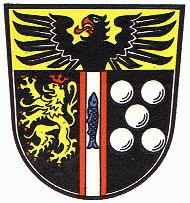Kaiserslautern (kreis): Difference between revisions
Jump to navigation
Jump to search
Knorrepoes (talk | contribs) m (Text replace - "'''Origin/meaning :'''<br/>" to "====Origin/meaning====") |
Knorrepoes (talk | contribs) m (Text replace - "|width="15%"|50 px|right |} " to "|width="15%"|50 px|right |}<seo title="Wappen, Gemeindewappen" /> ") |
||
| Line 3: | Line 3: | ||
|width="70%" align="center" |'''Heraldry of the World<br/>Civic heraldry of [[Germany]] - [[Deutsche Wappen|Deutsche Wappen (Gemeindewappen/Kreiswappen)]]''' | |width="70%" align="center" |'''Heraldry of the World<br/>Civic heraldry of [[Germany]] - [[Deutsche Wappen|Deutsche Wappen (Gemeindewappen/Kreiswappen)]]''' | ||
|width="15%"|[[File:Germany.jpg|50 px|right]] | |width="15%"|[[File:Germany.jpg|50 px|right]] | ||
|} | |}<seo title="Wappen, Gemeindewappen" /> | ||
'''KAISERSLAUTERN (KL)''' | '''KAISERSLAUTERN (KL)''' | ||
Revision as of 19:18, 5 November 2012
| Heraldry of the World Civic heraldry of Germany - Deutsche Wappen (Gemeindewappen/Kreiswappen) |
KAISERSLAUTERN (KL)
State : Rheinland-Pfalz
Origin/meaning
The arms were granted on December 14, 1959.
The lion in the lower part is the lion of the Pfalz, as the district historically belonged to the Pfalz. The bezants (balls) are taken from the arms of the Lords of Sickingen and stand for the Estate of Sickingen, now part of the district. The pale with the fish is taken from the arms of the city of Kaiserslautern.
The chief symbolises the different Imperial estates in the early Middle Ages in the present district.
Literature : Stadler, K. : Deutsche Wappen - Bundesrepublik Deutschland. Angelsachsen Verlag, 1964-1971, 8 volumes.

